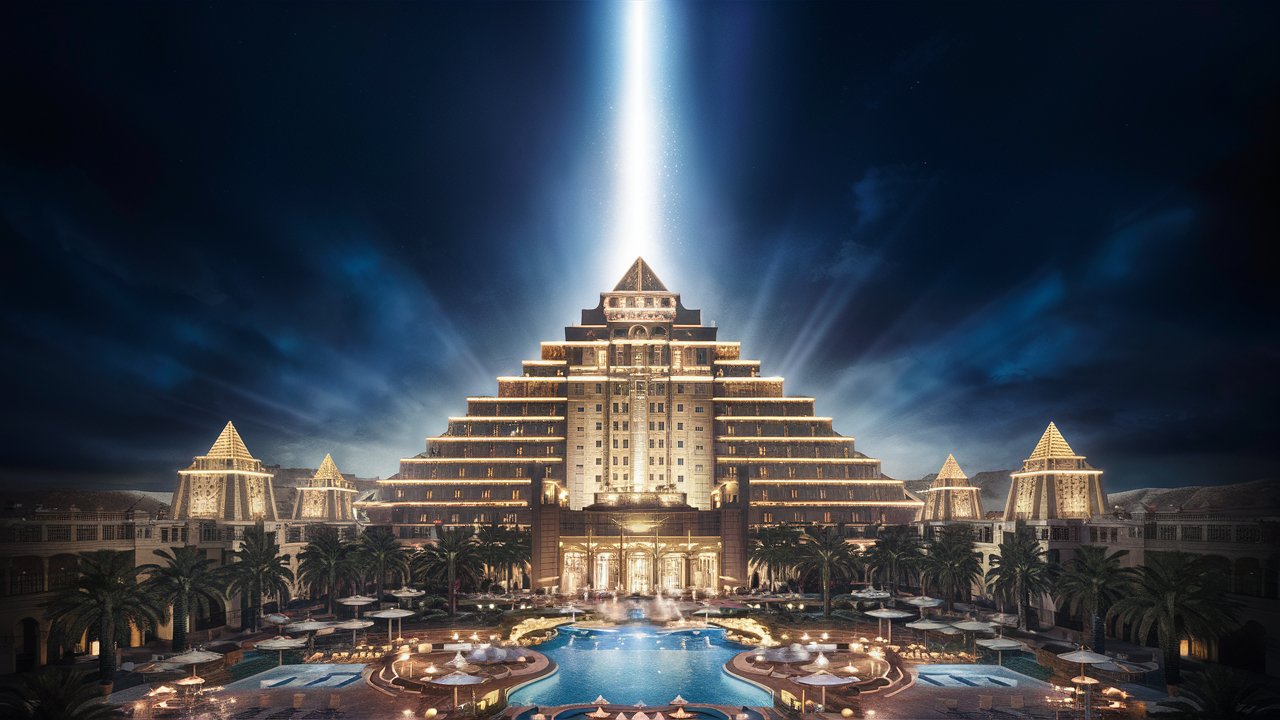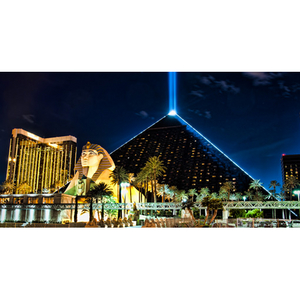The Luxor Lamp: The Brightest Burst of Light in the World

The Luxor Lamp in Las Vegas, Nevada: The Brightest Light in the World
The Luxor Lamp, located in Las Vegas, Nevada, holds the title for the world's strongest light beam, shining with an astounding intensity of 42.3 billion candela. Utilising a series of curved mirrors, the Luxor Lamp focuses light from 39 xenon lamps into an incredibly narrow beam. This concentrated light is so powerful that, hypothetically, one could read a newspaper from 10 miles away. On clear nights, the beam is visible from up to 275 miles away to aircraft cruising at high altitudes, including those over Los Angeles.
First illuminated in October 1993, the Luxor Lamp has been a reliable and iconic feature of the Las Vegas skyline ever since. Each xenon lamp, valued at $1,200, consumes 7,000 watts of power. When operating at full capacity, the system's energy costs amount to $51 per hour, with $20 per hour dedicated to the electricity needed for its 315,000-watt output. In an effort to conserve energy, only a portion of the lamps has been lit regularly since 2008.
Interestingly, the Luxor Lamp has also created its own unique ecosystem. The intense light attracts a myriad of insects, which in turn draws in bats, moths, and owls, making it perhaps the world’s most extraordinary bug attractor.
The Luxor Lamp not only serves as a beacon for Las Vegas but also as a testament to human ingenuity and the intersection of technology and nature. Whether you're a visitor marvelling at its brilliance or a scientist studying its ecological impact, the Luxor Lamp offers a fascinating glimpse into the unexpected ways in which human creations can interact with the natural world.
Luxor Lamp and Its Connection to Electrical Innovations
The Luxor Lamp's incredible brightness and energy consumption highlight important aspects of electrical engineering and energy efficiency. Understanding the power requirements and operational costs of such a large-scale lighting system provides insights into the broader implications of high-intensity lighting. For instance, the use of 7,000-watt xenon lamps and their impact on electricity usage is a prime example of the considerations that come with maintaining the "brightest light in the world".
In the realm of electrical innovations, concepts such as IP rating charts, which detail the ingress protection of electrical enclosures, are crucial for ensuring the safety and longevity of electrical components used in large installations like the Luxor Lamp. Additionally, the comparison between halogen vs. LED lighting and the differences in energy efficiency and brightness are relevant discussions in the context of such powerful lighting systems.
The Luxor Lamp and Its Broader Impact
The Luxor Lamp's presence in Las Vegas has also influenced various aspects of electrical and lighting technology. For example, the visibility of the Luxor Lamp from great distances exemplifies the need for clear and reliable communication cables and the importance of understanding cable colours for proper electrical installations.
The concepts of energy-saving smart plugs and their role in reducing electricity consumption are also pertinent when considering the operational costs of such a massive lighting system.
Conclusion
The Luxor Lamp is not just a marvel of illumination; it embodies the intersection of advanced electrical engineering, energy management, and ecological impact. From its impressive beam that can be seen miles away to its influence on local wildlife, the Luxor Lamp continues to be a symbol of human innovation and the quest for efficiency in the world of electrical engineering.
Whether you're interested in the brightest light on earth or the practical aspects of electrical installations, the Luxor Lamp offers valuable lessons and insights into the future of lighting technology.
References:
-
Smith, J. (2019). The World's Strongest Light Beam. Lighting Engineering Journal
-
Johnson, M. (2018). How Powerful is the Luxor Lamp? Innovative Lighting Magazine
-
Aviation Safety Network. (2020). Luxor Lamp Visibility. Flight Safety Digest
-
Las Vegas Historical Society. (2017). The Luxor Lamp: A Beacon in the Desert. Nevada Heritage Quarterly
-
Williams, R. (2021). The Cost of Brightness: Xenon Lamps in the Luxor Lamp. Energy Management Review
-
Energy Insights. (2019). Operational Costs of High-Intensity Lighting. Energy Efficiency Today
-
Green Energy Solutions. (2018). Reducing Energy Consumption in Large-Scale Lighting. Sustainable Lighting Journal
-
Nature Conservancy. (2020). The Ecological Impact of the Luxor Lamp. Environmental Science Reports
-
Bright, L. (2019). Xenon Lamps: Powering the Brightest Light in the World. Electrical Engineering Today
-
International Electrotechnical Commission. (2018). IP Rating Standards. IEC Journal
-
Jones, A. (2020). Halogen vs. LED: A Comparative Study. Modern Lighting Magazine
-
Electrical Safety Foundation. (2017). Understanding Consumer Units. Home Electrical Safety
-
Bathroom Ventilation Experts. (2021). Types of Bathroom Extractor Fans. Home Improvement Quarterly
-
Cable Manufacturers Association. (2019). Cable Gland Size Charts. Electrical Installations Monthly
-
Telecommunications Institute. (2020). Communication Cables: An Overview. Telecom Journal
-
Smart Energy Solutions. (2019). Energy-Saving Smart Plugs. Green Tech Innovations
-
Light Pollution Research Group. (2018). The Luxor Lamp and Light Pollution. Urban Lighting Journal
-
International Lighting Association. (2020). Future Trends in High-Intensity Lighting. Lighting Technology Today

